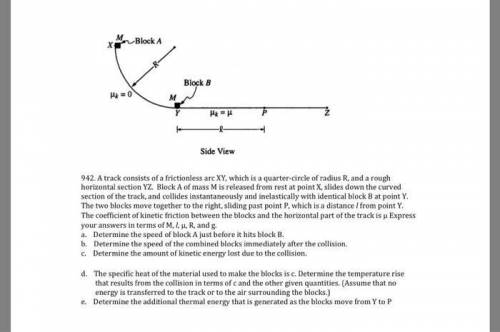
A track consists of a frictionless arc XY, which is a quarter-circle of radius R, and a rough horizontal section YZ. Block A of mass M is released from rest at point X, slides down the curved section of the track, and collides instantaneously and inelastically with identical block B at point Y. The two blocks move together to the right, sliding past point P, which is a distance l from point Y. The coefficient of kinetic friction between the blocks and the horizontal part of the track is ì. Express your answers in terms of M, R, ì, R, and g.

Answers: 2


Another question on Physics

Physics, 21.06.2019 22:00
In a wind tunnel the speed changes as the cross sectional area of the tunnel changes. if the speed in a 6' x 6' square test section is 100 mph, what was the speed upstream of the test section where the tunnel measured 20' x 20'? use conservation of mass and assume incompressible flow. conservation of mass requires that as the flow moves through a path or a duct the product of the density, velocity and cross sectional area must remain constant; i.e., that ova-constant. a model is being tested in a wind tunnel at a speed of 100 mph if the flow in the test section is at sea level standard conditions, what is the pressure at the model's stagnation point? (a) the tunnel speed is being measured by a pitot-static tube connected to a u- tube manometer. what is the reading on that manometer in inches of water? (b) at one point on the model a pressure of 2058 psf is measured. what is the local airspeed at that point?
Answers: 2

Physics, 22.06.2019 05:30
The a992 steel rod bc has a diameter of 50 mm and is used as a strut to support the beam. determine the maximum intensity w of the uniform distributed load that can be applied to the beam without risk of causing the strut to buckle. take f.s. = 2 against bucklin
Answers: 3

Physics, 22.06.2019 19:00
The particle p starts from rest at point a at time t = 0 and changes its speed thereafter at a constant rate of 2.8g as it follows the horizontal path shown. determine the magnitude and direction of its total acceleration (a) just before point b, (b) just after point b, and (c) as it passes point c. state your directions relative to the x-axis shown (ccw positive) and choose the angle with the smallest magnitude.
Answers: 1

Physics, 22.06.2019 22:00
The inside surface of a cylindrical-shaped cave of inner diameter 1.0 m is continuously covered with a very thin layer of water. the cave is very long and it is open on both ends. the water on the cave surface is at a constant temperature of 15.5 °c. the cave is constantly exposed to wind such that 15.5 °c air flows through the cave at 4.5 m/s. the kinematic viscosity of the air is 14.66 x 10-6 m2/s and the molecular diffusion coefficient of water vapor in the air is 0.239 x 10-4 m2/s. because the cave diameter is so large, the flow of wind down the length of the cave, in the x direction, can be treated like it is external flow and the cave surface can be approximated as flat where appropriate. calculate the x value, in a) the transition to turbulent flow occurs at rex meters, where the air flow transitions from laminar to turbulent along the inside surface of the cave b) calculate the x value, in meters, where the bulk steady state concentration of water vapor in the air flowing in the cave is 10% of the saturation concentration. assume the air at the surface of the water layer is 100% saturated with water vapor. assume the wind entering the cave contained no moisture before it entered the cave. take into account the transition from laminar to turbulent flow when solving part b
Answers: 1
You know the right answer?
A track consists of a frictionless arc XY, which is a quarter-circle of radius R, and a rough horizo...
Questions










Physics, 23.01.2020 04:31






Social Studies, 23.01.2020 04:31

English, 23.01.2020 04:31


Geography, 23.01.2020 04:31




